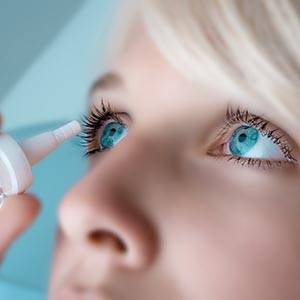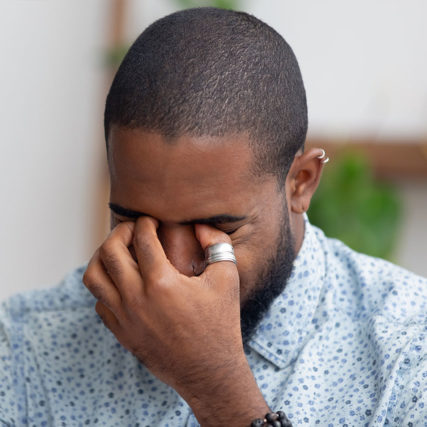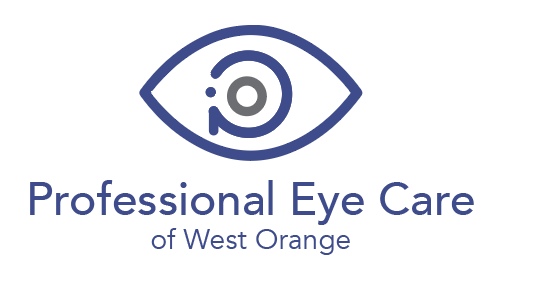What is Dry Eye Syndrome?
Dry Eye Syndrome, referred to as DES, is a chronic eye condition that occurs when the eyes produce an insufficient amount of tears or when the tears lack the essential balance of elements to lubricate the eye’s surface. A well-lubricated eye blocks foreign bodies or substances from irritating the eye’s surface.
Dr. Schlussel treats patients from all over West Orange, helping them achieve long-lasting relief from dry eye syndrome.


What Causes Dry Eye?
There are numerous causes and risk factors that contribute to the development of dry eye syndrome.
Activities That Cause Dry Eye:
When you stare at something you tend not to blink as frequently, and the lack of blinking actually causes the eyes not to replenish the tears often.
The main component of tears is water. Most of us don’t drink enough water. If you are dehydrated or not drinking enough, then you may not produce enough tears to keep your eyes moist. Snapple, Coke and other caffeinated drinks like coffee and tea may feel like they quench your thirst, but they actually dehydrate the body. Your body needs water to prevent dry eyes symptoms.
Environmental Factors and Dry Eye:
Environmental conditions can also play a role in dry eye syndrome. Exposure to cigarette smoke, dry air and pollen are also common dry eye causes.
Medications and Dry Eye:
Speaking of which, certain medications are known to contribute to dry eyes; in particular, allergy medication. Especially pervasive at this time of year, the use of Claritin or other antihistamines to control eye allergies or systemic allergies, will often lead dry eye symptoms.
Another widespread type of medication that can certainly cause dry eye symptom is beta blockers used for blood pressure.
Women that are on antigen therapy are likely notice symptoms of dry eyes. They tend to have a lot more irritation.
Age and Dry Eye:
Hormonal changes can cause dry eyes; women especially over 50, and men as they age in general, are more prone to developing dry eye symptoms.
Systemic Diseases and Dry Eye:
Rheumatoid arthritis, and Sjogren’s syndrome, which is a common symptom that rheumatologists treat, can also contribute to dry eyes. Diabetics or those with Glaucoma that requires medication are more likely to have dry eye syndrome.


Blepharitis and Dry Eye:
Another very common cause of dry eyes that we are seeing more and more is something called blepharitis, or meibomian gland dysfunction. That is inflammation of the lid glands that allow produce the oil in the tear film.
Over time, those glands that line the lids can get clogged and the oils in your tear film don’t flow on top of the tear film to protect it. People suffering from meibomian gland dysfunction are producing tears, but they’re evaporating too quickly.
So in between blinks, the tear film is just drying up or breaking down. That causes redness and other symptoms and classic signs of dry eye. We call that evaporative dry eye. Some suggest that many years of staring at a computer screen increase the prevalence of chronic blepharitis.
Headaches and Dry Eye:
I recently came across an interesting study about the correlation between migraines and dry eyes. They looked at 33 migraine sufferers and compared them to 33 people without headaches. The results showed greater prevalence of dry eye in the migraine group than in those without headaches.
So, researchers are speculating that some migraines may worsen when dry eye symptoms are present. Another study I read recently looked specifically at office work and hypothesized that headaches that people complain of are really being caused by dry eyes.
However it is unclear whether one causes the other, or whether computer use is a contributing cause of both headaches and dry eyes.
Common Dry Eye Symptoms
Patients with DES experience a number of symptoms that can disrupt their daily activities or cause chronic pain.
The most common signs of DES include the following:
- Blurriness
- Burning
- Dryness
- Feeling as if something is in your eye
- Irritation
- Itchy eyes
- Pain
- Red eyes
- Stinging
- Watery eyes
Those who suffer from DES often try to alleviate the pain by blinking either less or more often, rubbing their eyes, or by using over-the-counter artificial tears.
Why is blinking important? Blinking naturally moisturizes the eyes and gets rid of tiny particles that may enter the eye. Reduced blinking can increase dryness, itching, or redness, making DES symptoms even more acute.
Rubbing your eyes, especially when they’re already irritated, can intensify your symptoms. This is because the added pressure can make the pain worse. Moreover, if your hands aren’t 100% clean, you can unintentionally spread germs or bacteria into your eyes when you rub them. Rubbing the eyes can also cause tiny blood vessels to break, increasing the redness of your eyes.
Artificial tears provide temporary relief by lubricating the eyes with a specific solution. These can be quite effective at alleviating soreness and itchiness, however, excessive use isn’t recommended. Many brands include preservatives, which aren’t good for your health in the long term. Other preservative-free brands can, over time, fail to relieve the basic dry eye symptoms. Patients may find that having to continuously purchase artificial tears can become costly, and consistently using them throughout the day disrupts their daily activities.
Dry Eye Treatments
DES is typically treated with medicated eye drops, anti-inflammatory drops, or a heated compress. Occasionally, the eye doctor may recommend punctal plugs.
These are tiny devices that when inserted into the eye’s tear duct, block any drainage. This can alleviate DES symptoms by preventing moisture from draining out of the eye, ensuring that they stay inside the tear duct area. This increases the moisture level and provides longer-term relief.
Moreover, punctal plugs are not permanent and can be easily removed or replaced, making them a simple, affordable solution to alleviate symptoms.


We offer the latest Diagnostic and Treatment
Professional Eye Care of West Orange uses the latest diagnostic equipment and emerging, FDA approved technology to quickly and accurately pinpoint and treat the root cause of your dry eye problem. We don’t just throw any old drops at you either.
We provide custom treatment plans designed to maximize the relief of your dry eye symptoms AND treat the underlying cause of your discomfort.
Professional Eye Care of West Orange is now offering the Marco Equinox Low Level Light Therapy (LLLT), the latest in dry eye treatment technology.
Developed by NASA, LLLT has proven effective at treating dry eye disease. LLLT uses specially designed LED lights to gently warm up the eyelids, causing the meibomian glands to unclog and release oils.
• Safe, non-invasive procedure
• 15 minutes per session
• No recovery time needed
• No side effects or discomfort
• Safe for adults and children
Click here to learn more about this exciting NEW dry eye treatment.
* New treatment modalities are generally not covered by health insurance
Dry Eye Technology
Advancements in medical technology and scientific breakthroughs have made treatment for dry eye easier, offering quicker results and longer-lasting benefits. Some of the latest technologies for DES treatment include InflammaDry, LipiFlow, and TearLab.
Professional Eye Care of West Orange has some of the most cutting-edge and advanced technologies to quickly and effectively test for Dry Eye Syndrome. Let Dr. Schlussel and the talented, experienced staff help get you started on the path to real long-term relief from dry eye.
InflammaDry
Our tears contain a natural protein enzyme called matrix metalloproteinase-9, or MMP-9. Patients with Dry Eye usually have elevated levels of this protein.
The InflammaDry system measures MMP-9 levels by analyzing the tears taken from inside the lower eyelid. The entire process is fast and results are received in about 10 minutes. The disposable test is performed in the office, making it a top choice for eye doctors and DES patients.
LipiFlow
Meibomian glands are located by the eyelashes, towards the edge of the eyelid. These glands secrete oils, which lubricate the eye and keep your tears moist. When the glands become blocked, dry eye develops.
The LipiFlow system takes detailed images of the tear film, helping the eye doctor determine whether you have MGD. Then, a combination of gentle heat and light pressure is applied on both the inside and outside of the eyelid, removing the blockage and stimulating your eye’s natural moisture. The procedure takes around 12 minutes to administer and is done at the practice.
TearLab
The TearLab device measures concentration levels in human tears. This helps diagnose DES by noting any levels of tear concentration that are elevated, which signal dry eye.
TearLab is a 3-in-1 device: the test card, test pen, and countertop unit. The test card is a single-use microchip that collects a tiny sample of tear fluid in under 30 seconds. It sits inside the test pen, which analyzes and sends the data to the reader, located in the unit. The unit rests on a flat surface and displays the test results within seconds.
Restasis® Eye Drops for Dry Eyes
One of the most common dry eye treatments we prescribe is Restasis®. Rerstasis® is an eye drop that is used twice a day. It’s the tear drop form of cyclosporine, a medication that is prescribed for many chronic conditions, and it has been found to alleviate the symptoms of dry eyes as well.
The downside of Restasis® is that, when you first start taking it, it causes some burning of the eye in some patients, and it does take up to 3-6 months to really work its way into the body.
Restasis® seems to improve the quantity of the watery part of your tears, but it doesn’t necessarily help to improve the outflow of the oil that needs to be produced on top of the tears so that the tears don’t evaporate. Right now some of the studies are suggesting that over 50% of people with dry eyes actually have meibomian gland dysfunction. So, if the first lines of treatment are failing to manage dry eye symptoms, consider more rigorous treatments for dry eyes and blepharitis.
Treatments for Blepharitis and Dry Eye
There are some treatments aimed at treating blepharitis and meibomian gland dysfunction in particular. One of the more common methods we recommend in the office is using a warm compress with massage. Really, a hot compress should be used multiple times a day for the most effective dry eye relief. TranquilEyes makes goggles fitted with gel packs to make the hot, moist eye treatment more convenient. That will loosen the blockages in the oil-producing glands and help reduce the symptoms. However, that process requires consistency and effort, and it doesn’t get to the root of the problem.
There is a medication we often prescribe in the office called AzaSite®. It’s Azithromycin in eye drop form. AzaSite® is used twice a day for two days and then once a day for the remainder of the month. That prescription dry eye treatment seems to be pretty effective, but, like hot compresses, the dry eye treatment is dependent upon patient compliance.
Xiidra
Xiidra, also known as Lifitegrast, is a major breakthrough medication because unlike Restasis and other medications, it treats both the cause and the symptom and requires less time for it to show significant improvement.
While Restasis only showed significant improvement in 15% of those in trials, Xiidra’s trials have shown overwhelming improvement in as little as two weeks. In addition to its improvment in efficacy and speed, Xiidra shows improvment over the existing drugs used to treat dry eyes, with a low level of side effects and high safety profile.
Dry Eye Omega 3 Benefits
There are a number of commercially available products. The one we carry in the office, made by PRN works very well, but certainly any of the Omega 3’s that are available are helpful in reducing the symptoms of dry eyes.
- The Right Form and Serving. 4 softgels per day of our patent pending Dry Eye Omega Benefits® provides 2-3 grams of Omega-3s in the re-esterified triglyceride form (rTG).*
- Heart healthy benefits. 2-3 grams of Omega-3s per day has been shown to provide heart-healthy benefits.*
- Safe. This product offers an effective and safe way to increase your omega-3 intake.*
- Third party tested for purity. Dry Eye Omega Benefits® is third party tested for over 400 contaminants. Our unique molecular distillation process guarantees the removal of significantly more PCBs (known carcinogens) than non-molecularly distilled omega-3 products commonly found over the counter.
Dry Eye Exam With Dr. Alan B. Schlussel
When we see patients in the office we have begin by having the patient fill out a history form. There’s also a discussion kit developed by Allergan. They actually have a great website called My Dry Eyes that presents plenty of information about dry eyes and goes over things you could discuss with your doctor when you go in for an exam, and you can write away for them to send you a kit with suggestions and tips.
During the exam, we ask about the dry eye symptoms and other questions that give us insight into the potential causes of dry eye, and find out what – if any – self-management has been done up until now to try to treat dry eye. Then we work together to coordinate the best treatment plan.
We do a very thorough examination. We spend a lot of time evaluating the tear film, looking at the different layers of the tear film. We measure the quantity and evaluate the quality of the tears produced by the eye, paying particular attention the oil produced in the tear film.
Ultimately, we try to diagnose what type of dry eye you have; whether it’s the evaporative, or whether it’s mucus deficient or water deficient.
Then we develop a treatment plan based on different methods that we use to treat different types of dry eyes. As your eye care professional, we can coordinate that and try to stay behind what you’re doing.
I will spend the time. I’m very understanding of dry eyes because I have it myself. I’ve been treating my own eyes for about five, six years. And a lot of my patients have been coming in with numerous complaints about dry eyes, and we can help a lot of you.

